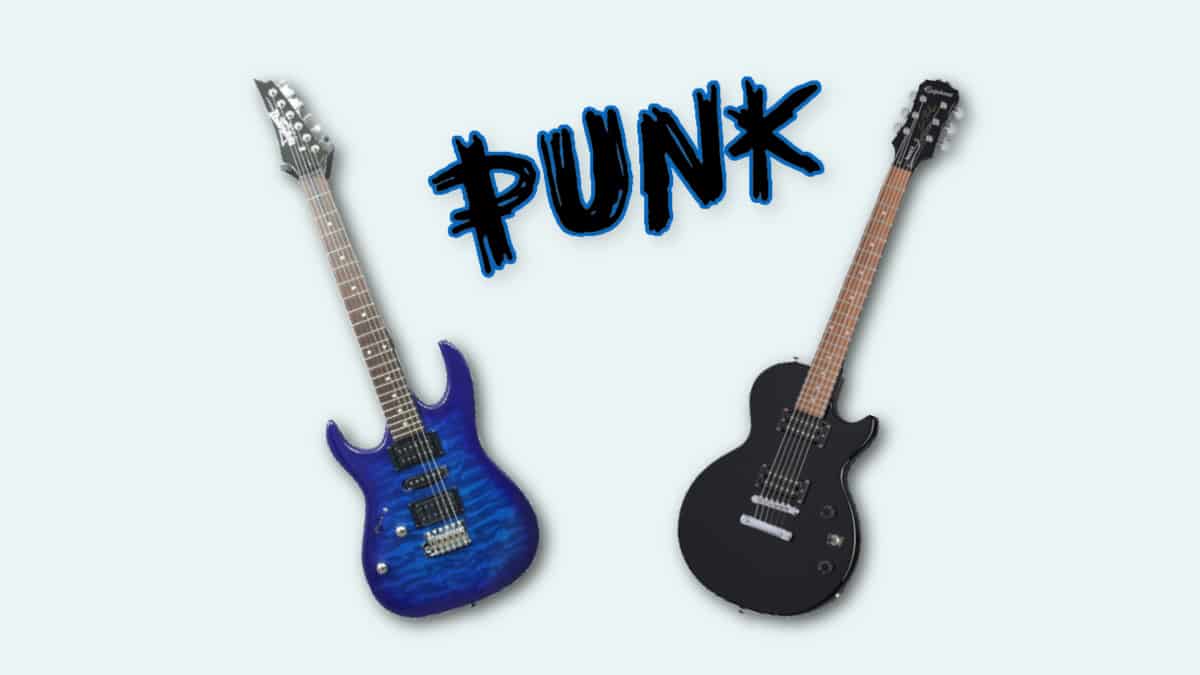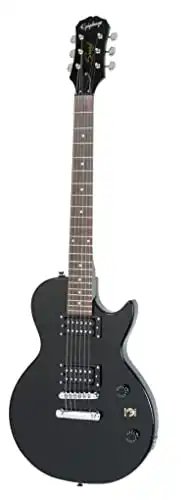Wanna cut to the chase? I reviewed best punk guitars, and my top pick was the Fender Player Telecaster Electric Guitar.
Replicating the sound of punk takes skill, passion, and the right guitar.
So what’s the best guitars for punk, you ask?
Let’s first start by asking ourselves: What is punk? Is it the fast, heavy strumming, the anti-establishment lyrics, the clipped sounds, the stripped-down instrumentals, the nasal shouting?
For me, the thing that defines punk rock is the fast, steady guitar. Chugging away throughout the song, it’s the continuous guitar strumming that really amps me up.

Listening to Johnny Ramone hurtle through the chords in Blitzkrieg Bop or Steve Jones pounding away in Anarchy in the UK gets my blood pumping.
It’s like the speed of their guitar becomes my heartbeat. After a few songs, I’m more than ready to storm ‘The Man’.
The early punk bands used what they had on hand to create their frenetic sounds.
At the time of punk’s rise, the 1970s, Gibson Les Pauls were easy to come by.
Punk was all about breaking away from the over-complicated sound of 70s rock. Cheap and easily available guitars won out.
Nowadays, Gibson Les Pauls are generally out of the price range of most hobbyists and beginners.
Luckily though, there are lots of great-sounding guitars available to let your inner punk out!
Ready to rock?
Top Pick: Fender Player Telecaster Electric Guitar
The big brother of the Squier in this list, the Fender Telecaster is a beautiful guitar. It has made iconic punk tracks with The Clash and The Damned.
Alder is used for the body, which has a slightly thicker back than some guitars. It makes it feel substantial and gives you something to pound against as you’re bashing out those chords.
The maple, satin-finished neck is smooth to move around without feeling slippery.
This is one of the things that sets the Telecaster apart from similarly priced guitars. It is just so playable!
Two single-coil pickups give the classic bright Fender sound. These are very good quality pickups.
They give a clean, crisp, unadulterated sound. When used with gain, they can create a thicker, clashing sound perfect for punk.
The hardware is top-notch. It’s the same quality as the hardware that fender sells individually for you to outfit other guitars.
The only issue is the bridge. It’s a string through a bridge which means that you have to pass the strings through a hole. It can be fiddly if you’ve never done it before.
Also, those of you who like to rest their hand on the bridge will need to adapt. The Telecaster uses bent steel saddles to raise the strings. It means that there is no block for you to rest on.
If you want to read up on the different types of bridges, this is a great guide.
What I Like
- Beautiful shape and finish.
- Satin-feel fret and neck for ultimate playability.
- High-quality pickups and hardware.
- Made from alder and maple woods.
- Versatile tones.
What I Don’t Like
- Fiddly bridge set-up.
- Slightly thicker neck than other brands.
Best for Beginners: Squier by Fender Affinity Telecaster
Squier is Fender’s entry-level guitar range. They are cheaper than traditional Fenders but still offer a quality experience.
Probably the first thing you notice about this guitar is the beautiful finish. The colors are rich and warm and looks so good with the metal hardware.
It’s worth noting that you can get the Squier in all the same finishes as the Telecaster. So if you love the Race Green or Arctic White Fender, you are in luck!
Made from alder and maple, this guitar is bright in color and sound. The alder body is a real bonus as it is much harder to damage than basswood or poplar. These woods are often used in budget guitars and dink easily.
The neck has a bit of a ‘c’ shape to it making it slightly thicker than some of the other guitars here.
It does make it ever so slightly harder to get your hand round for those power chords.
The pickups are vintage-style single coils that give the guitar a more mellow sound. The bridge pickup is placed at an angle to pick up the deeper bass notes.
It also helps bring out the really bright top notes. Essentially this kind of placement gives you range.
As this is a budget option, the pickups aren’t top quality. There is a little bit of a buzz to them, especially when played through a cheaper amp.
What I Like
- Made from high-quality materials.
- Gorgeous finishes and paint jobs.
- Sturdy tuners.
- Excellent tonal range.
- Thin body shape.
What I Don’t Like
- Some buzz in the pickups.
- Slightly thicker neck.
- Fairly flimsy hardware.
Best Budget: Epiphone Les Paul Special II Electric Guitar
Epiphone is owned by Gibson and is pretty much their budget brand. Epiphone brings you the shape, style, and sound of a Gibson without the $1000 price tag!
The Les Paul Special became the guitar of choice of punk rockers because it was so simple.
The current Les Paul Special II stays true to its roots having only picked up a pickup switch in over 50 years.
The body is made from solid mahogany and has a fairly substantial feel to it. The frying pan shape is iconic and gives you plenty of room to strum through.
The neck is a bolt-on neck, meaning it is attached to the body with a bolt. This is one of the ways Epiphones reduces the cost of the guitar.
It doesn’t hold sustain like the Gibson, but it’s good enough.
The hardware on this guitar is quite surprising. The bridge, pickups, and tailpiece are what you’d find on more expensive guitars.
They feel solid, make great sounds, and look fancy.
The tuners are at the other end of the spectrum. They just feel sort of flimsy. According to users, the guitar does hold its tuning fairly well.
The issue with the tuners seems to be mostly a cosmetic issue.
What I Like
- Made from good quality materials.
- Alternative body shape.
- Some high-quality hardware.
- A cheaper option for Gibson lovers.
- Slim body and neck profile.
What I Don’t Like
- Flimsy feeling tuners.
- Uncomfortable placement of the pickup switch.
- Fretboard feels a little rough initially.
Runner Up: Epiphone SG Special VE Electric Guitar Cherry
A poplar body with the classic double SG cutaway design, the Epiphone SG is a loving tribute to the classic Gibson SG.
Poplar seems to be an odd choice for this guitar. It’s not the strongest wood out there and can dent fairly easily.
Gibson SGs were known for being durable on the road but the Epiphone SG just can’t take a hit.
The overall look is great though. It has a worn finish which makes it look loved right out of the box. If you’re not a fan of glossy finishes then this is a good option.
The neck has a d-shaped profile which can feel a bit cumbersome in smaller hands. It wouldn’t be my first choice of shape for a punk guitar.
However, the neck and fretboard are glorious. Epiphone has used a satin finish on the neck which makes it feel smooth and helps you move around.
The rosewood fretboard is beautiful and accents the cherry red body.
The pickups are Humbuckers but they use ceramic magnets. Sometimes, ceramic magnets make the tone feel a bit flat. For a deeper dive into the pros and cons of ceramic pickups, check out this article.
That being said, the sound out of the box isn’t bad. The humbuckers do give you a really powerful sound if a little one dimensional.
What I Like
- Beautiful finish and coloring.
- Satin-finish neck.
- Powerful, heavy sound.
- Ergonomic design.
What I Don’t Like
- Ceramic pickups are a bit flat.
- The D-shaped neck can be cumbersome.
- The poplar body is prone to dents.
Runner Up: Ibanez 6 String Solid-Body Electric Guitar
Ibanez guitars are usually associated with metal, but they are a great choice for punk rock as well.
The body is made from mahogany and basswood, giving it a warm and sturdy feel.
The neck is maple with a rosewood fret and pearl inlays. The rosewood neck helps pick up the lower sounds. It adds a lot of depth to the instrument.
Ibanez guitars have famously slim profile necks. These make power chords much easier.
You can get your fingers into shape without having to hold onto huge amounts of wood.
The five humbucker pickups will allow for some serious gain. Kicked up to full, the gain will push you into the realms of metal.
But, if you balance it right, you’ll get a great dirty punk sound.
This is an entry model Ibanez so there are a few issues here and there. If you’re an experienced player then you will probably notice them a lot more.
The strings are the biggest problem. The guitar is shipped with cheap strings that have a habit of buzzing.
You can fix this easily, but it’s annoying from a brand like Ibanez.
The pickups are slightly loose on arrival. Again, it’s a fairly simple fix but if left unchecked it will start to interfere with your sound.
What I Like
- Made from high-quality materials.
- Sleek design.
- Comfortable neck.
- Perfect tuning stability.
What I Don’t Like
- Cheap strings.
- Some reports of loose pickups.
Buyer’s Guide
To make great music, you need to understand your instrument. You need to know what its strengths and weaknesses are, and how to get the best out of it.
That’s why we’ve put together a buyer’s guide. Here you’ll find all the information you need to choose your next guitar.
What Makes a Good Punk Guitar?
Simplicity.
Punk doesn’t need loads of bells and whistles.
The Gibson Les Paul Junior became iconic because it was a guitar that you could plug in and play. You didn’t need to spend time refining the tone and volume, you just poured your heart into it.
When you’re looking for a guitar for punk don’t worry about what added features it has. Focus on the basics.
Neck
Punk rock uses a lot of power chords. These are chords that only have two notes but often require you to bar a few strings with your third finger. These are some of the chords you would learn in a beginner’s guitar music theory class.
If you’ve never done this before it can be quite uncomfortable.
A sleek, comfortable neck will make power chords much easier on the hands. You want a neck that has a fairly slim profile so you can get your fingers around the strings.
Some good shapes to go for are modern flat ovals which are pretty dang thin, or a classic ‘u’ shape.
Tuning Machine Head
This is the top of the guitar where the strings end up. The machine head is what you use to tune the strings.
For punk rock, you need a pretty strong machine head.
You’re going to be bashing away at those strings pretty hard. A poor-quality machine head won’t be able to take that force. You’ll find that the strings go out of tune after a few songs.
Constantly having to retune is a nightmare. It kills your vibe and ruins the music when it detunes mid-song.
If you’re able to see the guitar in person and try it out take a close look at the machine head. Try turning the keys and see how stiff they are.
Body
The body of your guitar is going to take a lot of use and abuse as you pound your way through chords.
Make sure you have solid wood in your body. Fenders tend to be made of alder or ash. Gibsons tend to use mahogany or maple.
You don’t have to go for the most expensive guitar but be warned cheap guitars often use laminates for the body.
Laminate bodies are much more susceptible to dinks and dents. They just aren’t as strong as solid woods.
You want a solid body guitar for punk. Hollow body electrics are just too soft and bluesy.
If you’re a bit confused about the difference, a hollow body guitar will be much thicker. Hollow body electric guitars are like the offspring of an electric and acoustic guitar.
Pickguard
The pickguard is a piece of plastic or laminate that sits below the strings. It is there to stop your pick from scratching the paintwork or finish on your guitar as you play.
The speed of punk definitely increases the risk of scratching.
A pickguard is not essential but will save your guitar body finish from scrapes and scratches as you barrel through chords.
Most guitars have a pickguard already installed. Just try to make sure that the guard is wide enough to cover the area below your strings.
If you want to go for a scratched up, worn-out look you could remove the pickguard or choose a guitar without one.
Sustain
Sustain is all about how long the strings reverberate after you’ve strummed them. Seems simple right?
Well, it’s actually a complex process that involves a lot of different parts including the strings, the nuts, and the bridge.
You don’t need to know the details about it but do make sure to check reviews and descriptions for information about sustain.
For punk rock, you want long sustain. Part of the punk sound is the clashing chords that sort of bleed into one another. Sustain will allow chords to reverberate even as you move onto the next one.
Shape
Ok, yes, punk is about breaking rules, being different. You might be tempted to go for an unusually shaped guitar just to be different. If that’s what you want, go for it, but be careful.
You will be strumming very quickly when you play punk so you want a comfortable shape. This means a place to rest your arm as you strum, and easy access to the strings.
There are great punk guitarists who have had guitars with alternate shapes.
The Gibson Firebird’s tilted shape was a favorite with some early punk bands because it was completely different.
The Rickenbacker’s frying pan shaped body has produced some of punk’s biggest hits. Ramones, Green Day, and The Slits have all used Rickenbackers in their line up.
FAQs
How do I play punk rock?
Power chords and lots of them!
Punk rock wanted to be different from the music that surrounded them. They felt that the disco, rock, and pop of the 70s was too manufactured. So they went for simple setups and fairly basic playing styles.
The key skills you’ll need to master are fast strumming and power chords. Most classic punk songs are 4 chords or less. The variation and originality of each song come from the strumming pattern and progression.
To get the heart-pounding beat of punk you need to be able to keep a steady beat. Work on your rhythm, particularly downstrokes. As this is what carries the song.
Lead guitar in punk is almost non-existent. Solos aren’t a major feature so you don’t need to focus on fingering techniques.
Some more modern punk bands like Green Day do bring in some pop elements like riffs and solos. Still, though, rhythm is the biggest focus of a punk guitarist.
Can I get a cheap version of an iconic guitar?
You can, but the question is should you?
Look, everyone has a dream guitar they’d love to own. You stick a picture of it on your desk and you work and save for it.
In the meantime, you’ll be better off getting a good quality mid-range guitar to practice with. It seems counterproductive to spend more on a guitar when you’re trying to save. Ultimately it will save you money in the long run.
The problem with cheap guitars is that the craftsmanship is often lacking. Unfortunately, you don’t only see the poor quality, you hear it.
A cheap, poor quality instrument is not going to sound good. Even if you now look like Joe Strummer of The Clash with a knock-off Fender, you will not sound like him.
Nothing kills your love of playing more than a crackling, buzzing guitar. If the craftsmanship isn’t there, you can nail the playing and still sound terrible.
Cheap guitars also tend to break. The body and neck are usually made with low-grade materials that just can’t take the use and abuse.
You’ll find yourself replacing a poor-quality, inexpensive guitar over and over. It’s much better to buy a decent one that will last you years.
Any listening suggestions for punk?
Oh boy! Strap in, we’ve got a lot of recommendations!
To get a sense of the roots of the genre, you need to start with the original punks. Take a look at The Ramones, The Clash, The Sex Pistols, and The Damned.
Personally, I love The Ramones. Check out songs like ‘Gimme, Gimme Shock Treatment’ and ‘Suzy Is A Headbanger’ for a great sense of their style.
These guys were the first wave of punk. After them came bands like Joy Division, The Buzzcocks, and a personal favorite, The Slits.
The 80s brought us Human League, The Replacements, and Bad Brains. These bands took the New Wave punk sound and ran with it. They brought electronic elements into punk and made it the sound of the 80s.
To get a feel for punk in the 90s you have to listen to Green Day or Sonic Youth. These bands kept punk alive in the face of grunge and EDM.
In the 00s pop-punk was king. It’s quite different from the original sound of punk but you can hear the influence. I love Bowling for Soup, Sum 41, Blink-182, and Paramore.
These were the bands that sent me down the punk path. Some purists like to turn their nose up at pop-punk. I think it’s a great gateway to punk!
Final Thoughts
So there you have it, 5 of the best guitars for punk. Hopefully, you’ve found your next guitar on this list. If you have, let us know how you like your new sidekick!











